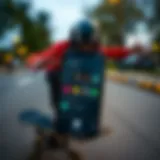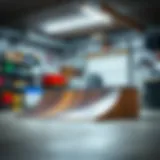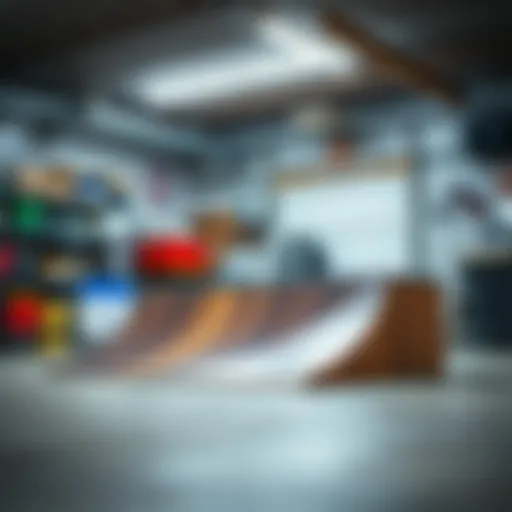Trippy Outfits: Skate Culture Meets Psychedelic Fashion
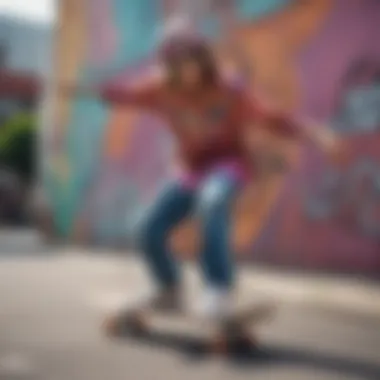

Intro
In a world where expression meets rebellion, the vivid blending of skate culture and psychedelic fashion offers a captivating look into the vibrant lives of skateboarders. This intersection is not just about clothes; it’s a visual representation of an ethos. Trippy outfits, embellished with sundry colors, intricate patterns, and imaginative designs, carve a space for individuality amid the dynamic atmosphere of skateboarding.
Skate culture, historically rooted in freedom and creativity, provides a platform where self-expression flourishes. The spontaneous nature of skateboarding encourages individuals to convey their identities through style. In this realm, the use of artistic flair, inspired by the psychedelic eras of the 60s and 70s, revitalizes personal aesthetics. These flamboyant outfits not only serve as a medium of self-expression but also foster a sense of belonging among skaters.
As we traverse this terrain, we will discover how trippy outfits accentuate the spirit of skateboarding, a world where visual aesthetics and athleticism meld seamlessly. We will touch upon key aspects, such as relevant skills and gear that embody both style and function, ensuring that our insights are useful for skaters at all levels. This article aims not only to inform but also to inspire, encouraging readers to embrace their uniqueness.
"Fashion is the armor to survive the reality of everyday life."
Embracing this mindset, let us dive into the skills development segment, which lays the groundwork for the functional side of skateboarding, coupled with aesthetic expression.
Historical Context of Psychedelic Fashion
Psychedelic fashion is not just a whimsy of bright colors and funky patterns; it’s a vivid chronicle interwoven into the larger fabric of cultural history. Its significance lies in how it reflects social dynamics, artistic movements, and the search for identity— particularly poignant in skate culture where individual expression reigns supreme. The vibrancy of psychedelic aesthetics offers a backdrop that shapes how skaters present themselves and interact with their surroundings. Getting to grips with the historical context lends deeper understanding to how these bold fashion choices emerge from cultural currents that transcend mere style.
Origins of Psychedelic Aesthetics
Psychedelic aesthetics find their roots in the cultural upheavals of the 1960s, where the convergence of art, politics, and music birthed an entire ethos. Early incarnations sprang from abstract art movements, particularly surrealism and abstract expressionism, which encouraged artists to push visual limits. Artists such as Peter Max and Andy Warhol infused their work with vibrant color palettes and extravagant imagery, laying the groundwork for later styles.
Furthermore, the influence of psychedelic experiences—often induced by drugs—further honed this aesthetic. The imagery became synonymous with inner exploration and cosmic interconnectedness, as landscapes of mind opened up into dizzying arrays of colors and forms. Hence, trippy outfits became a way to manifest this visual experience outwardly through expressive clothing.
Influence of the 1960s Counterculture
The 1960s counterculture didn't just alter politics; it drastically reshaped the fashion landscape. It embraced a rejection of the prevailing norms, encouraging freedom of expression. This rebellion was vividly articulated through colorful clothing, tie-dye techniques, and oversized silhouettes that spoke to a generation questioning rigid societal norms.
Skate culture, which developed alongside this movement, adopted these broad strokes of individuality. Skaters began to dress not just for function but for style, blending elements of psychedelic fashion to stand out on their boards. The aesthetic spoke of creativity and rebellion, a visual language that resonated with the risk-takers of the skate world. As they carved out their identities on the asphalt, those patterns of psychedelic fashion became symbolic of their defiance against conformity.
The Role of Art Movements
Several art movements not only influenced psychedelic fashion but also fostered a rich dialogue between fashion and visual arts. Dada, with its anti-art sentiments, paved the way for an avant-garde approach to expression. The unpredictable elements of Dada coincided with the unexpected combinations found in psychedelic attire. The interplay of art forms became vital, encouraging styles that married high art with subculture expressions.
Additionally, the poster art of the 1960s, particularly in the San Francisco scene, can’t be overlooked. Posters for concerts often showcased intricate designs and vibrant colors, communicating radical ideas visually. This non-verbal communication became crucial for both artists and skaters, filtering down into the clothing choices that marked the scene.
In summary, the historical context of psychedelic fashion provides an essential framework for understanding the intersection with skate culture. The cultural references, artistic foundations, and political movements all contribute to this vibrant tapestry. As skateboarders embrace these influences, they not only showcase style but also carry forward a legacy of individuality and artistic freedom—an ongoing story that begins long before their own journeys on the board.
Trippy Outfits in Skateboarding Culture
The integration of trippy outfits within skateboarding culture represents more than mere fashion choices; it genuinely encapsulates the ethos of freedom and self-expression that defines the skate community. Skateboarding, an activity rooted in individuality and rebellion, finds its aesthetic counterpart in psychedelic fashion. When skateboarders don quirky, vibrant attires, they’re not just making a style statement; they’re communicating their identity and often reflecting a deeper connection to the larger societal tapestry.
Embracing Individuality
One of the cornerstones of skateboarding culture is the celebration of individuality. For many skaters, their outfit is an extension of who they are. With trippy outfits, they have the opportunity to stand out in an arena that often values uniqueness above all else. The colorful, bold choices allow skaters to express their moods and personalities, whether they're wearing oversized tie-dye shirts or patterned baggy pants that dance with every trick.
"In a world where most blend in, skateboarders choose to stand out. Those bright designs and eclectic styles become a loud proclamation of individuality."
Key Elements of Individuality in Outfits:
- Use of bright colors and unusual patterns
- Personalization through DIY techniques or unique finds
- Inspiration drawn from personal experiences and backgrounds
Psychedelic Patterns and Graphics
The vibrant patterns found in trippy attire are a hallmark of the psychedelic fashion movement. These designs often blend geometric shapes with flowing lines and whimsical motifs, creating a visual feast that draws the eye. Many skateboard brands have adopted these psychedelic influences into their product lines, offering apparel that stands out on and off the board.
Skaters often gravitate toward graphics that resonate with their values and lifestyle, bridging the gap between fashion and art. Skateboard graphics themselves often feature similar psychedelic characteristics, which enhances the overall aesthetic. Each outfit becomes a canvas, celebrating both creativity and culture in a vivid display.
Examples of Psychedelic Elements:
- Bold fractals and swirling patterns
- Nature-inspired designs that symbolize freedom, like yin-yangs or dreamcatchers
- Bright, clashing colors that evoke energy and positive vibes
Notable Skateboarders and Their Style Choices
Throughout the years, many notable skateboarders have made significant impacts not just in the sport, but also within the realm of fashion. Their style choices often reflect their personal narratives and the various influences they've embraced. For example, Tony Hawk has often been seen sporting bright graphic tees and baggy shorts, making a statement about comfort while capturing the essence of the skate culture.


Another figure, Zoe Laird, has showcased how psychedelic wear can be combined with functionality, often incorporating rubberized patterns in her skate outfits for both style and performance. Each choice they make influences young skaters looking for role models, suggesting that what they wear matters just as much as how they ride.
Skaters Known for Their Unique Style Choices:
- Tony Hawk: Graphic tees paired with bright colors
- Zoe Laird: Use of functional psychedelic designs
- Milo Koller: Incorporation of personalized graphics on skate decks and clothing
In summary, trippy outfits within skateboarding culture flourish by promoting individuality, showcasing psychedelic patterns that reflect deeply rooted artistic influences, and through the bold style choices made by notable skaters. As skate culture continues to evolve, so too does the expressive capacity of its fashion, allowing for a myriad of interpretations.
Through this colorful lens, the connection between skateboarding and psychedelic fashion reveals itself not just as an aesthetic, but as a fundamental expression of identity.
Material and Functionality
In the world of skateboarding, where self-expression dances with functionality, the choice of materials is no trivial matter. Skaters don’t just step onto their boards; they embody a blend of art and activity that reflects their identity. The fabric of their attire plays a significant role in this narrative. When we talk about trippy outfits, we delve into how the right materials not only enhance performance but also serve as a medium of personal expression. The connection between what you wear and how you skate is essential—one that begins with understanding the fabric.
Choosing the Right Fabrics for Performance
Performance is paramount in skateboarding. The freedom of movement is crucial, and the right fabric can make a world of difference. Breathable materials like cotton or specific synthetic blends can wick moisture, ensuring comfort during those intense sessions. Lightweight options such as ripstop nylon or polyester can provide durability without sacrificing agility. Additionally, these materials often come with some flexibility, allowing skaters to execute intricate maneuvers with ease.
Consider the following fabrics when gearing up:
- Cotton: Soft and naturally breathable; great for casual wear but may absorb sweat.
- Polyester: Lightweight and quick-drying; excellent for performance wear.
- Spandex: Offers stretch, accommodating a full range of motion—ideal for tricks.
When matching these materials with trippy designs, the result is a tapestry of comfort and style that represents the unique flair of skate culture.
Durability vs. Aesthetic Appeal
Striking the balance between robustness and visual appeal is like navigating a tightrope for many skaters. While aesthetic allure might draw attention, durability ultimately becomes a necessity on the pavement. Trippy outfits can employ vibrant colors and psychedelic prints, but if the fabric isn’t built to withstand the wear and tear of sharp landings or rough surfaces, it won’t last long before fraying or tearing.
Yet it’s essential to recognize the increasing innovation in the textile industry. New technologies emerge that blend both durability and style. Fabrics that are water-resistant, fade-resistant, or even scratch-resistant can showcase bold graphics without compromising longevity. In many ways, the modern skater is like an artist combining elements of expression and practicality, where those who skate hard demand materials that flow with resilience and flair.
"Fashion and function are not opposites; they can coexist beautifully in the world of skate culture."
Psychological Impact of Fashion in Skateboarding
Understanding the psychological impact of fashion within skateboarding reveals a fascinating layer of how individual identity and group dynamics blend seamlessly on the pavement. Outfits do not merely serve a functional purpose; they carry the weight of personal expression and emotional resonance, shaping how skateboarders perceive themselves and are perceived by others. This intricate relationship between fashion choices and psychological frameworks can create a ripple effect, influencing confidence levels, community belonging, and even performance.
How Outfits Affect Confidence
When it comes to confidence, the adage "dress for success" holds true in the realm of skateboarding. The clothing skaters choose to wear often reflects their own perceptions of self-worth and status within the community. Vibrant colors, unique patterns, and bold graphics can ignite a sense of assurance. Skaters are more likely to tackle challenging tricks or embrace new skate spots when they feel good in what they’re wearing.
Moreover, unique and expressive outfits can draw attention, leading to positive reinforcement from peers. The feeling of being noticed—as opposed to blending into the background—enhances a skater's self-esteem. It can become an empowering cycle: confident dressing leads to confident performing, which then further solidifies their identity within skate culture.
"Your outfit is like your armor; it shields you and boosts your game on and off the board."
Fashion as a Form of Expression
Fashion serves as an unspoken language among skateboarders, allowing them to communicate their values, influences, and personalities without saying a word. Every garment choice tells a story—whether it nods to the rich history of skate culture, reflects a tie to psychedelic art, or embodies a personal journey through its striking colors and patterns. When skaters curate their style, they not only assert their individuality but also forge connections with like-minded individuals.
Skateboarding is rooted in rebellion and creativity, making it only natural for individuals to adopt fashion that embodies these principles. Trippy outfits that feature swirling patterns or mind-bending graphics resonate deeply with skaters, drawing parallels with the freely expressed experiences during their rides. As skate culture continues to evolve, the freedom of expression through clothing only becomes more profound, often leading to fashion moments that challenge societal norms.
This aspect of fashion expands horizons beyond merely aesthetics; it creates an inclusive environment. Skaters with diverse backgrounds, experiences, and perspectives come together, using fashion as a vehicle for collaboration and inspiration. The boldness seen in their outfits often reflects upon their lives—a metaphorical and literal demonstration of the eclectic nature of skate culture.
Creating Trippy Outfits: A Guide
Creating trippy outfits is more than just about looking good while skating; it’s about making a statement, embracing individuality and adding personal flair to one's wardrobe. The importance of this topic lies in how clothes can become an extension of one’s personality. This guide will enlighten readers on various elements that make trippy outfits truly unique, covering everything from mixing colors to DIY techniques.
Mixing Colors and Patterns
When it comes to trippy outfits, colors and patterns play a critical role. The blend of vibrant shades can evoke feelings of energy and excitement, essential in skate culture. Think about it: a dull outfit can hardly match the thrill of soaring through the air on a skateboard. Here are some points to consider:
- Color Psychology: Different colors can evoke different emotions. Bright reds and yellows may ignite excitement, while blues and greens can evoke a sense of calmness.
- Pattern Pairing: Mixing patterns can sound daunting, but it’s all about balance. Try to combine geometric prints with organic shapes for a juxtaposition that pops. This method adds depth to an outfit.
- Layering Techniques: One trick is to layer—maybe a patterned shirt under a colorful jacket. This technique allows you to express your creativity while being practical.
Finding Inspiration from Nature
Nature is a treasure trove of design inspiration. The colors and patterns found outdoors can easily translate into mesmerizing outfits. Picture vibrant sunsets or a lush forest. Here’s how you can draw from Mother Nature:
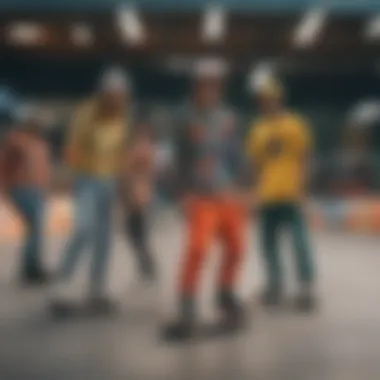

- Observe Color Combinations: Take note of how certain colors blend in various environments. For instance, the blooming wildflowers during spring present a fantastic range of color palettes.
- Natural Patterns: Look at the intricate designs found in leaves or the mesmerizing patterns of animal skins. These can inspire everything from shirt graphics to shoe designs.
- Seasonal Changes: Each season brings its own set of colors and textures. Transitioning your outfits with seasonal themes not only enhances your wardrobe but also connects you with nature.
DIY Customization Techniques
DIY techniques provide one avenue to create personalized trippy outfits without breaking the bank. Customization allows for a sense of ownership and uniqueness, further setting you apart from the crowd. Here are some practical ideas:
- Tie-Dye: It’s a classic for a reason. By dyeing fabrics with various colors, you can create eye-catching, one-of-a-kind garments. Be careful not to over-dye; less is often more.
- Patching: Adding patches to clothing is an excellent way to display personal interests or even commemorate places you’ve visited. They not only look cool but also allow for commentary on your skate journey.
- Painting: For the more artistically inclined, fabric paints can help you create your designs. Freehand drawings or stencils on jackets can turn a simple piece into a work of art.
Customizing your outfits gives you an edge. It reflects your journey, your thoughts, and your vibe.
In sum, creating trippy outfits requires a blend of imagination, intention, and playfulness. It’s about enjoying the process and expressing who you are as a skater—bold, vibrant, and utterly unique. Each piece you choose to wear can reflect not only your style but also a moment, an experience, or an emotion.
Trendy Accessories to Complement Trippy Outfits
In the realm of skate culture, where self-expression reigns supreme, accessories play a crucial role in completing a trippy outfit. These elements not only enhance the overall look but also reflect the wearer's personality and style. Accessory choices can amplify the vibrant aesthetic associated with psychedelic fashion, allowing skaters to bridge the gap between function and form, while staying true to their individual flair.
Footwear Choices for Enhanced Performance
When it comes to skateboarding, footwear is not simply an accessory; it's a lifeline. The right shoes can significantly affect performance on the board, but they should also resonate with the vividness of a trippy outfit. Skate shoes like Vans Old Skool or Nike SBs are often the go-to for their grip and durability.
Moreover, opting for shoes with psychedelic patterns or colorways can create a harmonious visual flow with the rest of the outfit. For instance, a pair of multi-color Vans paired with brightly printed shorts brings life to the skating scene. Pay attention to features such as:
- Grip: Essential for skateboarding, ensuring safety during tricks.
- Cushioning: Enhances comfort, especially for prolonged wear.
- Style: A unique design can make a bold statement.
Finding the right balance between aesthetic appeal and practical performance is key.
Headgear: From Beanies to Bucket Hats
Headgear has evolved from mere protection to a fashion statement in skate culture. Beanies and bucket hats, for instance, don’t just keep the head warm; they complete a look that screams individuality.
- Beanies can lend a casual, laid-back vibe to an ensemble, typically pairing well with colorful tee shirts and patterned pants. The fabric’s texture often complements the psychedelia theme.
- On the other hand, bucket hats, known for their wide brims, can serve as a canvas for bold colors and intricate designs, making them an eye-catching accessory.
These choices reflect the skater's mood and style, shaping how they are perceived on and off the board. Both styles allow skaters to play with patterns and colors, adding layers to their personality while staying stylishly functional.
Statement Jewelry in Skate Culture
While skate culture might seem predominantly focused on clothing and footwear, jewelry has carved out its own niche. Statement pieces, ranging from colorful bracelets made from recycled skateboards, to chunky necklaces featuring psychedelic charms, can set one apart in a sea of skaters.
- Customizable options allow for personal touches, like beads in colors that match the outfit or keychains that have a personal memory.
- Rings and earrings can showcase an individual's tastes and serve as conversation starters when in a group setting. Popular choices might include metallic pieces mixed with bright enamels, offering a cheeky nod to the past with a modern twist.
Ultimately, jewelry can elevate an ensemble from ordinary to striking, capturing the essence of skate culture's vibrant spirit.
Accessories are the icing on the cake that completes the trippy aesthetic. They represent not just function but also the essence of who you are as a skater.
The Role of Influencers and Icons
The synergy between skate culture and psychedelic fashion cannot be understated. Influencers and icons play a pivotal role in shaping these trends, introducing vibrant styles that speak to the essence of self-expression. These figures not only showcase various aesthetics but also inspire a community to embrace unique identities and styles. The significance of their influence extends beyond mere fashion; it encompasses a broader understanding of cultural trends, lifestyle choices, and artistic movements that continue to evolve.
Prominent Figures in the Fashion Scene
Identifying prominent figures within the intersection of skate culture and psychedelic fashion leads one to a mix of artists, skateboarders, and fashionistas who have carved their own niches. Think of Tony Hawk, the legend who had a way of integrating colors and bold designs into his skate shoes and apparel, paving the way for future collaborations. Then there’s Vans, a brand that has embraced a whimsical blend of skate culture with floral and kaleidoscopic designs, positioning itself as a staple in both skating arenas and fashion runways.
Moreover, there’s the haunting yet compelling influence of artists like Andy Warhol, whose pop art has inspired countless skateboard graphics that stand out in their trippiness. These figures creativity forms a backdrop where colors mingled wildly, just like a spray of paint on a canvas.
Their impact isn’t just about what they wear; it’s about the message they send. When a well-known skater wears a tie-dye shirt or a pair of checkerboard pants, it's not just a wardrobe choice, it’s a declaration. It embodies the spirit of freedom, risktaking, and the courage to stand out in a scene often defined by conformity.
Social Media's Influence on Style Trends
In today’s digital age, social media serves as the megaphone for influencers and icons alike. Platforms like Instagram and TikTok grant artists, skaters, and everyday enthusiasts the ability to showcase their styles to a global audience. This exposure fosters a community where trends can emerge overnight, morphing as quickly as the waves at a skatepark.
The ripple effect of a single post can’t be overstated. A pro-skater’s outfit featuring bold, swirling colors may inspire thousands of skate enthusiasts to adopt similar styles. Hashtags like #PsychedelicSkateFashion or #TrippyOutfits further amplify these choices, creating pathways for dialogue and collaboration over style preferences.
This aspect is particularly crucial when addressing younger audiences who are oftentimes the target for evolving trends. They are likely swayed by what they see, so the role of influencers is to present not just clothing but a lifestyle. By openly sharing their journeys through posts, stories, and live streams, they encourage others to embrace their own quirks and creativity.
In summary, influencers and icons serve as cultural bridges, linking skate culture to psychedelic fashion. Their impact endures, encouraging individual expression while fostering a community built on creativity and boldness. The resultant styles are more than clothing choices; they reflect a movement that supports authenticity, passion, and a very natural sense of rebellion.
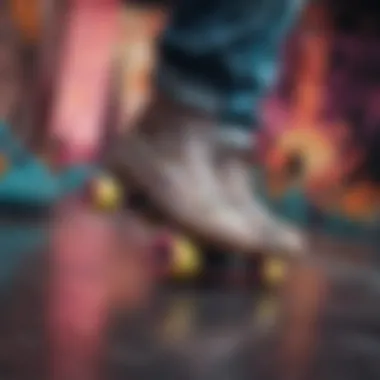

Sustainable Choices in Trippy Fashion
In the world of fashion, the call for sustainable choices has become a clarion call rather than a mere whisper. As the skate culture reflects a vibrant mix of individuality and freedom, it has also adopted an awareness of environmental concerns. The notion of sustainability resonates deeply within this culture, acknowledging that the lively outfits that define it come with social and ecological responsibilities.
Embracing sustainability in trippy fashion is not only a trend but a necessity. It encourages skateboarders to think critically about their choices, especially when it comes to materials and production practices. The intersection of sustainability and style becomes essential here, as it allows skaters to express their unique identities without compromising moral values.
Eco-Friendly Fabrics and Their Benefits
Using eco-friendly fabrics in trippy outfits contributes positively to the environment and the skin. Materials like organic cotton, bamboo, and hemp are often preferred due to their reduced pesticide usage and lower carbon footprints. Here are a few benefits that these fabrics bring to the table:
- Biodegradability: Unlike conventional materials, eco-friendly fabrics decompose naturally, helping to minimize landfill waste.
- Breathability: Fabrics such as organic cotton and linen offer excellent breathability, allowing for greater comfort while skating.
- Durability: Many eco-friendly options are designed to withstand wear and tear, making them suitable for the rigors of skateboarding.
By choosing clothing made from these materials, not only do skateboarders enhance their personal style but also contribute to a larger movement that prioritizes our planet's health.
"Fashion is about the journey of creativity and innovation, intertwined with responsibility for the earth we share."
Recycling and Upcycling Fashion Ideas
The practice of recycling and upcycling takes a creative spin on sustainability, infusing new life into old garments. Rather than tossing out clothing that has seen better days, skateboarders can innovate and repurpose, turning potential waste into bold fashion statements. Here are some ideas for incorporating these practices into trippy fashion:
- DIY Projects: Transforming old tees into fashionable tote bags or cutting down oversized jackets into stylish vests is an excellent way to craft unique looks.
- Swapping Events: Engaging in clothing swaps with fellow skaters allows for a fresh wardrobe without the environmental impact of fast fashion.
- Custom Designs: Adding hand-painted elements or patches from recycled materials can turn a basic outfit into something entirely personal and vibrant.
In this respect, the potential for creativity is vast, providing an avenue for self-expression that resonates with the aesthetic of psychedelic fashion. Moreover, recycling and upcycling not only contribute to sustainable practices but also cultivate a culture of ingenuity and resourcefulness within the skate community.
Future Trends in Trippy Outfits
As the realms of skate culture and psychedelic fashion intertwine increasingly, understanding future trends in trippy outfits becomes paramount. These trends not only reflect the evolving identity of skateboarders but also capture the spirit of the time. As styles shift, so do the materials, aesthetics, and innovations that define how skaters express themselves on and off the board. The fusion of these influences creates a vibrant tapestry, allowing for creativity and self-expression that resonate within the skate community.
Skaters are not just looking for comfort; they’re searching for a means to articulate who they are. In this dynamic landscape, skate gear serves as a canvas, bridging personal narratives with communal ethos. Skaters often gravitate towards bold colors, diverse patterns, and unique silhouettes that mirror their personalities. It’s this very nuance that will continue to shape future trends, ensuring that the culture remains fresh and relevant.
Emerging Styles and Aesthetic Innovations
In this segment, the spotlight is on new styles and the innovative approaches that are sprouting within trippy outfits. More than ever, designers are crafting collections that blur the lines between art, fashion, and functionality. One notable trend is the resurgence of retro-inspired graphics, reminiscent of the psychedelic designs from the late 60s and early 70s. Creatives are pulling inspiration from vintage concert posters or art movements like op art, where optical illusions play a huge role in pattern formation.
Expect to see:
- Tie-dye making a comeback, but with a modern twist, integrated into technical fabrics that perform under the demanding conditions of skateboarding.
- A rise in handcrafted accessories, such as belts and bags, that not only serve practical purposes but also inject unique style elements into a skater's outfit.
- The adoption of layering techniques, where pieces that traditionally don’t mix—such as bright, oversized shirts with snug pants—are now combined to create a distinctive silhouette.
Moreover, the concept of sustainability is becoming increasingly critical. Eco-conscious designs, which prioritize ethical sourcing and upcycled materials, are gaining traction. This attention to the environment reflects a growing desire among skaters to leave a positive mark on their community and the planet.
Technology's Impact on Fashion Choices
Now let's dive into the technological advancements that are shaping fashion choices in the skate culture. The integration of technology and fashion has opened a whole new realm of possibilities. Skaters are now able to access an array of resources that help them not only create but also curate their wardrobe.
- 3D printing is paving the way for custom pieces tailored to an individual’s needs, enabling unique designs that resonate with personal style.
- Innovative smart fabrics enhance performance; moisture-wicking and breathable materials are becoming standard, keeping skaters comfortable and dry during intense sessions.
- Social media platforms have fundamentally changed how trends are spread. Now, styles can go viral overnight, as skaters share their looks on platforms like Instagram or TikTok. This rapid dissemination allows for swift adoption of new trends or techniques across communities.
By staying ahead of these technological developments, skaters not only elevate their fashion game but also engage more deeply with the culture surrounding them.
The intersection of technology and design in trippy outfits is creating a vibrant, ever-evolving landscape. Whether it’s through innovative materials or the methods used to produce them, the impact is clear: it’s all about celebrating individuality while pushing the boundaries of skate fashion.
Case Studies of Iconic Trippy Outfits
Case studies of iconic trippy outfits serve as a fascinating lens through which we can explore the confluence of skateboard culture and psychedelic fashion. These examples illuminate the significant impact that style choices have on the identity of skaters while also reflecting broader aesthetic movements within society. By examining certain standout moments and outfits in this vibrant subculture, we uncover how fashion transfers beyond mere clothing into a powerful vehicle for personal expression.
Analyzing Legendary Skateboard Video Parts
Legendary skateboard videos like Video Days and The Bones Brigade Video Show are rich with examples of trippy outfits that not only capture attention but also symbolize the evolution of skate culture. In these pieces, the outfits often mirror the creativity and boldness found in the skating itself. For instance, Jason Lee's breakdancing backdrop in Video Days, featuring an eclectic mix of patterns and colors, epitomizes the artistic spirit of the skateboard scene in the early '90s.
In videos that followed, such as Almost: Round Three, the unique fashion choices showcased by pro skaters like Ryan Sheckler were unmatched. Notably, his neon-colored fits highlighted the shift towards vibrancy and individualism. Coupled with the precision of their tricks, these outfits became emblematic; every flip or grind was an extension of their personality and a visual statement that broke away from mainstream aesthetics.
"Fashion is art, and every trick is a stroke of genius on the canvas of life."
— Unknown Skate Culture Aficionado
Fashion Statements in Skateboarding Competitions
The visual impact of skateboarding competitions has also been shaped significantly by trippy outfits. Events like the X Games or Street League are not just showcases of skill but also platforms for fashion experimentation. This is where the blending of skate culture and psychedelic style truly shines.
In sporting arenas, the commentary often extends beyond performance. Skaters like Nyjah Huston are known for their gravity-defying tricks alongside their choice of loud, head-turning apparel. His aesthetic, while functional, reflects an understanding that every outfit serves as a statement. Colors that pop and designs that draw the eye paint a narrative of confidence and individuality.
On the flip side, outfits worn during these competitions can be deemed strategic, as they bolster a skater's persona, often becoming part of their brand. The right pair of tie-dye shorts or a bold graphic tee can resonate with fans, turning a simple skate session into a memorable spectacle.
In essence, studying these case studies reveals not just a style choice but a complex interaction where fashion becomes integral to the skateboarding experience, illuminating how deeply interconnected expression and identity are within the scene.


